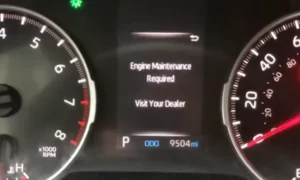The 2.4 liter Toyota engine is widely renowned for its quality, easy operation, inspiring performance, and long-lasting dependability. However, there are several common fault points associated with it. Continue reading to learn about the most common problems of the 2.4 Toyota engine, quick fixes, and simple preventative maintenance tips that will allow you to largely avoid issues in the first place.
Toyota 2.4 Liter Engine Problems
The 2.4-liter engine has been used on loads of different Toyotas since its debut in 2002. While it is known to have had some issues here and there, it is still looked on as a high-quality engine, and any problems that it develops are typically easily solved.
This reliable engine is considered by many to be one of the most dependable engines that Toyota has ever built, and when maintained properly, it should be relatively free of any major problems.
Now, let’s get into the most common fault points of the 2.4 liter Toyota engine – and some simple solutions to use if you experience them.
Weakened Cylinder Head Bolt Threads
If your cylinder head bolts weaken, coolant leaking can occur, which allows the coolant to flow through the cylinders and head gasket. You’ll need to act fast to rectify this situation in order to avoid major damage. The solution is simple and most novice mechanics are able to handle the work. Cylinder head bolt repair kits are available but are rather pricey, typically between $1000 and $1700. That price can be increased if you need other parts, like a new head gasket.
Burning Oil
Oil burning is perhaps the most common issue associated with the 2.4-liter Toyota engine. It happens because of improper positioning of the piston rings, and it typically onsets after the engine hits about 50,000 miles. It can get to the point where you’re going through about a liter of oil every 1200 miles, not good. If you don’t address this issue, you may experience total engine failure.
Unfortunately, this is not a problem that’s easily or cheaply solved. The engine is going to have to be removed, disassembled, repaired, reassembled, and reinstalled. This large, complex job requires extensive mechanical experience and costs as much as $7000.
Engine Overheats
If your 2.4 Toyota engine is overheating, you may just need to add some coolant. That’s the best-case scenario. However, it may also indicate the need for a radiator flushing, thermostat replacement, or another coolant system service. The best thing to do here is to take your Toyota to a reputable service station for an assessment.
You always hope for the best. A new thermostat is a quick and easy fix. A hose replacement is also simple but can cost up to $200. And if you need a new head gasket or a new radiator, you may be looking at prices in excess of $1500.
Defective or Damaged Piston Rings
Piston rings are inner engine components that regulate oil pressure. If the rings are worn, defective, or damaged, they can affect the engine’s performance. Your engine is unable to operate without piston rings. And you will know if your piston rings are wearing away because your car will smoke, burn oil, and operate poorly.
So, if you notice that your Toyota is smoking or you smell oil burning in the air, you should have it checked out quickly before more serious damage develops. New piston rings are inexpensive, typically costing less than $200. However, the labor needed to replace the worn piston rings can take 10 hours or more in the mechanic’s shop, which adds significantly to the price you’ll pay.
Redesigned 2.4 Liter Engine
The 2.4 liter Toyota engine was redesigned in 2008. The new design implemented new camshafts, an aluminum block, cast iron cylinder liners, slant-squish combustion chambers, direct injection, and variable valve timing. So, if you’re looking for a Toyota 2.4 engine for sale, you might be wise to choose one made during or after 2008.
Remember that whichever year of this engine you’re dealing with, common sense preventative maintenance is key to avoiding its usual fault points. If you stay on top of your maintenance chores and treat this engine kindly, it will very likely deliver many years of trouble-free performance.














